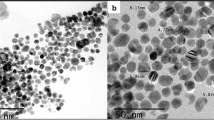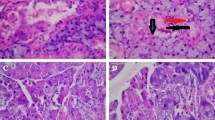Abstract
In vitro studies show that sodium selenite is a potential radioprotector in normal cultural cells, but not in tumor cells. The aim of this study was to evaluate the cytoprotective potency of sodium selenite during a conventional fractioned irradiation of the salivary glands of rats. The head and neck area of male WAG/RijH rats was irradiated with 60Co-γ rays (60 Gy/30 fractions/6 weeks). Sodium selenite (15 µg/kg body weight) was applied through a venous port 30 min before irradiation. Rats of a control group were treated in the same manner with an equal volume of physiologic sodium chloride. In the course of treatment, the salivary glands were resected at different stages and examined histopathologically. The evaluation of gland function was performed prior to and after radiotherapy by sialoscintigraphy. The irradiation caused dose-dependent damage in the salivary glands. Intra- and intercellular edema (16 Gy), vacuolization (30 Gy), degranulation (46 Gy) and necrosis of the acinar cells (60 Gy) occurred. Sodium selenite delayed the development of the described damage; additionally, the number of necrotic acinar cells after the application of 60 Gy was reduced (control, 75% vs. sodium selenite, 30%). The sialoscintigaphical results confirmed these results: the loss in gland function in the control group was 74 vs. 44% (P<0.05) in the sodium selenite group. Based on the morphological and sialoscintigraphical findings, a cytoprotective effect on the acute toxicity of the salivary glands of rats could be detected during irradiation with synchronous application of sodium selenite.




Similar content being viewed by others
References
Bohuslavizki KH, Brenner W, Tinnemeyer S (1997) Is quantitative salivary gland scintigraphy a mandatory examination prior to and after radioiodine therapy? Radiol Oncol 31:5–12
Brizel DM, Wasserman T, Henke M, Strnad V, Rudat V, Monnier A, Eschwege F, Zhang J, Russel L, Oster W, Sauer (2000) Phase III randomized trial of amifostine as a radioprotector in head and neck cancer. Int J Radiat Oncol Biol Phys 18:3339–3345
Brooks JD, Metter EJ, Chan DW, Sokoll lJ, Landis P, Nelson WG, Muller D, Andres R, Carter HB (2001) Plasma selenium level before diagnosis and the risk of prostate cancer development. J Urol 166:2034–2038
Chao CKS, Deasy JO, Markman J, Haynie J, Perez CA, Purdy JA, Low DA (2001) A prospective study of salivary function sparing in patients with head-and-neck cancers receiving intensity-modulated or three-dimensional radiation therapy: initial results. Int J Radiat Oncol Biol Phys 49:4:907–916
Chao KS, Majhail N, Huang CJ, Simpson JR, Perez CA, Haughey B, Spector G (2001) Intensity-modulated radiation therapy reduces late salivary toxicity without compromising tumour control in patients with oropharyngeal carcinoma: a comparison with conventional techniques. Radiother Oncol 61 3:275–280
Diamond AM, Dale P, Muray JL, Grdina DJ (1996) The inhibition of radiation-induced mutagenesis by the combined effects of selenium and the aminothiol WR-1065. Mutat Res 356:147–154
Dörr W, Riesenbeck D (2000) Mundhöhle. In: Dörr W, Zimmermann JS, Seegenschmiedt MH (eds) Nebenwirkungen in der Radioonkologie: Klinisches Kompendium. Urban und Vogel, Munich, pp 130–142
Haddad P, Karimi M (2002) A randomised, double-blind, placebo-controlled trial of concomitant pilocarpine with head and neck irradiation for prevention of radiation-induced xerostomia. Radiother Oncol 64:29–32
Hehr T, Bamberg M, Rodemann (1999) Präklinische und klinische Relevanz der radioprotektiven Wirkung von Natriumselenit. Info Onkol 2 [Suppl 2]:25–29
Hu YJ, Diamond AM (2003) Role of gluthathione peroxidase 1 in breast cancer: loss of heterozygosity and allelic differences in the response to selenite. Cancer Res 63:3347–3351
McDonald S, Meyerowitz C, Smudzin T, Rubin P (1994) Preliminary results of a pilot study using WR2721 before fractionated irradiation of the head and neck to reduce salivary gland dysfunction. Int J Radiat Biol Phys 29:747–754
Micke O, Bruns F, Mucke R, Schafer U, Glatzel M, DeVries AF, Schonekaes K, Kisters K, Büntzel J (2003) Selenium in the treatment of radiation-associated secondary lymphedema. Int J Radiat Oncol Biol Phys 56:40–49
Micke R, Büntzel J, Schönekaes KG, Micke O (2003) Selen in der Onkologie: Wirklich ein “noli nocere”? Internist 44:2:227–229
Nagler RM, Baum BJ (2003) Prophylactic treatment reduces the severity of xerostomia following radiation therapy for oral cavity cancer. Arch Otolaryngol Head Neck Surg 129:247–250
Patchen ML, MacVittie TJ, Weiss JF (1990) Combined modality radioprotection: the use of glucan and selenium with WR-2721. Int J Radiat Oncol Biol Phys 18:1069–1075
Rudat V, Asadpour B, Zeh D, Wannemacher M, Debus J, Münter M, Hoffner S, Schlegel W (2001) Prospektive Untersuchung zur Schonung der Speicheldrüsenfunktion bei Patienten mit Kopf-Halskarzinomen: Vergleich IMRT versus Amifostin. Strahlenther Onkol 177:63
Rudat V, Meyer J, Momm F, Bendel M, Henke M, Strnad V, Grötz K, Schulte A (2000) Protective effect of amifostine on dental health after radiotherapy of the head and neck. Int J Radiat Oncol Biol Phys 48:5:1339–1343
Sagowski C, Tesche S, Zywietz F, Wenzel S, Metternich FU (2004) The radioprotectors amifostine and sodium selenite do not modify the radiosensitivity of rat rhabdomyosarcomas. Onkologie 27:(DOI:10.1159/000075605)
Sagowski C, Wenzel S, Metternich FU, Kehrl W (2003) Studies on the radioprotective potency of amifostine on salivary glands of rats during fractioned irradiation: acute and late effects. Eur Arch Otorhinolaryngol 260:42–47
Sagowski C, Wenzel S, Tesche S, Jenicke L, Jaehne M (2003) Investigation on the radiosialadenitis during fractioned irradiation: Sialoscintigraphical and histomorphological findings in rats. Eur Arch Otorhinolaryngol 260:513–517
Sagowski C, Wenzel S, Tesche S, Jenicke L, Kehrl W, Roeser K, Metternich FU (2004) Reduktion akuter radiogener Schädigungen in der Glandula parotis der Ratte unter fraktionierter Bestrahlung durch Natriumselenit. HNO 52:( DOI: 10.1007/s00106–003–0992-x)
Scarantino CW, Levenque F, Scott C, White RL, Rotman M, Hodson DI, Meredith R, Foote L, Brachman DG, Lee N (2001) A phase III study on the concurrent use of oral pilocarpine to reduce hyposalivation and mucositis associated with radiation therapy in head and neck cancer patients. Final results of RTOG 97–09. Int J Radiat Biol Phys 51 [Suppl 1]:85–86:A152
Seifert G, Mielke A, Haubrich J, Chilla R (eds) (1984) Strahlen-Sialadenitis. In: Speicheldrüsenkrankheiten. Thieme, Stuttgart, New York, pp 140–146
Seifert G (1996) Strahlen-Sialadenitis. In: Doerr W, Seifert G, Uehlinger E (eds) Spezielle pathologische Anatomie. Oralpahologie I: Pathologie der Speicheldrüsen. Springer, Berlin, Heidelberg, New York, pp 196–208
Seikaly H, Jha N, McGaw T, Coulter L, Liu R, Oldring D (2001) Submandibular gland transfer prevents postoperative radiation induced xerostomia. Laryngoscope 111:347–352
Shannon IL, Starke EN, Wescott WB (1977) Effect of radiotherapy on whole salivary flow. J Dent Res 44:656–661
Sill R (1999) Bedeutung von Selen in Prävention und komplementärer Therapie. Pharm Ztg 144:2508–2513
Weiss JF, Hoover RL, Kumar KS (1987) Selenium pre-treatment enhances the radioprotective effect and reduces the lethal toxicity of WR-2721. Free Radic Res Commun 3:33–38
Yadav SP, Gera A, Singh I, Chanda R (2002) Serum selenium levels in patients with head and neck cancer. J Otolaryngol 31:216–219
Ziegler H, Stegmaier C (1996) Bevölkerungsbezogene Krebsregistrierung in Deutschland. Onkologie 19:268–277
Author information
Authors and Affiliations
Corresponding author
Rights and permissions
About this article
Cite this article
Sagowski, C., Wenzel, S., Jenicke, L. et al. Sodium selenite is a potent radioprotector of the salivary glands of the rat: acute effects on the morphology and parenchymal function during fractioned irradiation. Eur Arch Otorhinolaryngol 262, 459–464 (2005). https://doi.org/10.1007/s00405-004-0859-0
Received:
Accepted:
Published:
Issue Date:
DOI: https://doi.org/10.1007/s00405-004-0859-0




